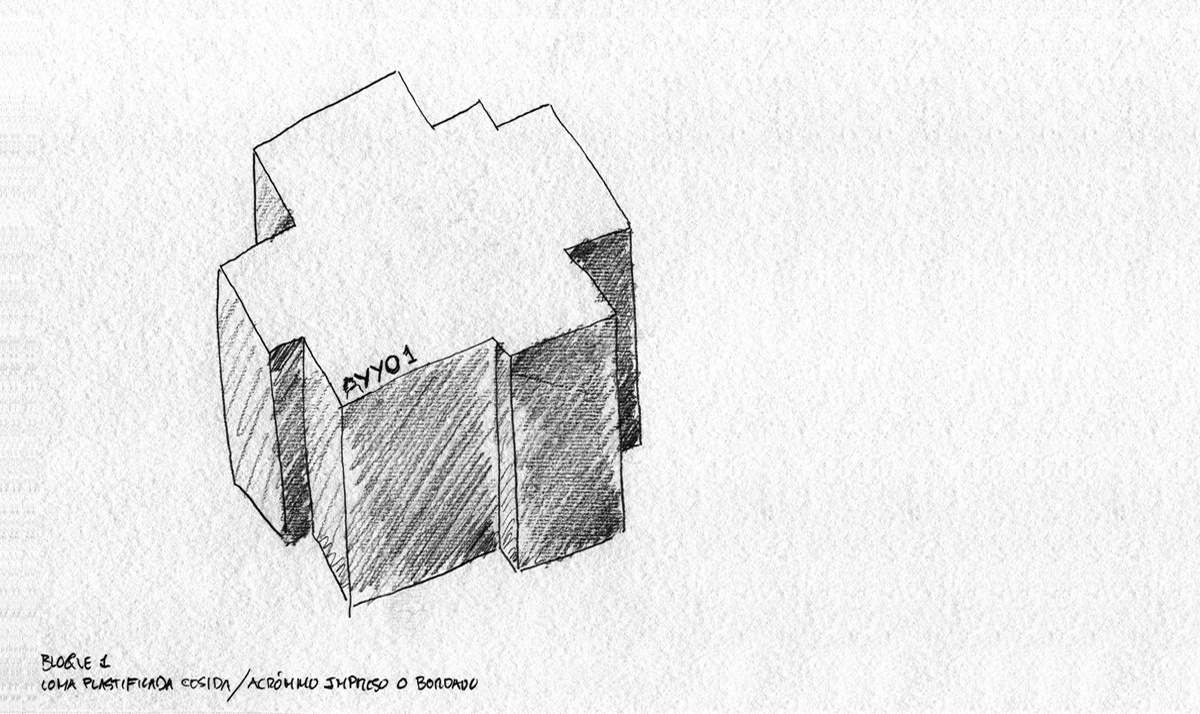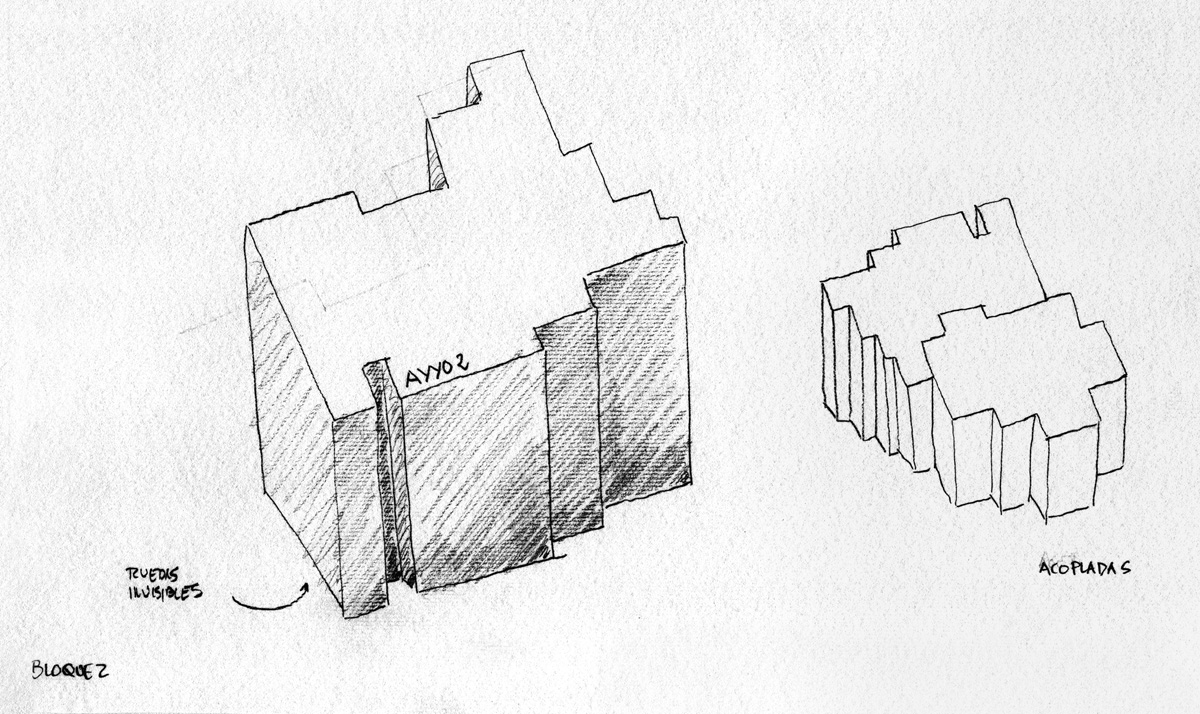

AYYO, una donación
En desarrollo. CA2M 09/24_05/25
AYYO será un cajón de sastre, totalmente ordenado, donde condensaré mi experiencia del proyecto Arquitectura y «Yo» (+ info), la compartida y la de todos mis colaboradores. Dentro de esas mesas se guardarán los restos, los despieces, los fragmentos (el polvo de mis dibujos, las esquirlas de los lápices, la cinta de carrocero hecha bola, las maderas para construir Regreso al hogar, la peana de Todos mis amigos me parecen guapos, el sobrante de los vinilos de corte, las pruebas y la plancha original de Horizon, el velcro enrollado, etc., etc.) en definitiva el «basurismo», como yo lo llamo, de todas las etapas y todos los procesos de Arquitectura y «Yo». A esto sumaré el material documental de la exposición, los bocetos del proyecto y la cartelería de sala escrita por mi a mano, y reconvertida una vez retirada y encuadernada en libro de artista.
El resultado será un compendio, un resumen de meses de trabajo guardados dentro, y apiladas bajo las dos mesas diseñadas en un principio como display expositivo, y transformadas finalmente en obras de arte. Para su conservación museográfica se cubrirán con dos lonas impermeables blancas cosidas a medida con el acrónimo AYYO estampado.
El producto de esta última operación serán dos esculturas con ruedas, a modo de maquetas sobredimensionadas de bloques o edificios ciegos, independientes e interdependientes; ya que podrán ser almacenadas y expuestas individualmente o en una sola pieza, cubiertas o como contenedores con todo el material catalogado visible.
Los materiales y los ejercicios que hagamos juntos con el departamento de conservación del museo serán el punto de partida para preguntarnos ¿Qué sucede antes, durante y después de una exposición? ¿Cómo son esos procesos, quiénes son sus agentes, qué roles y responsabilidades desempeñan y asumen cada uno de ellos? ¿Cómo se expone, cuantifican, califican, ordenan, catalogan y difunden los resultados de una exposición? ¿Es un proceso cerrado? ¿Qué queda de todo ello? Obras, experiencias, conocimientos, materiales, desechos.
Finalmente, AYYO plantea el acto de donación de la obra a la Comunidad de Madrid, requisito firmado en el contrato expositivo de mi proyecto Arquitectura y «Yo» en la sala Alcala 31, como un acto de generosidad por ambas partes (artista e institución) y también de todas las personas implicadas en el proyecto. Esta cuestión enlaza con otro de mis proyectos UMPA (Un mensaje para Anabel, Museo ABC, 2011) donde el objeto de reflexión era la idea de colección “entendida como una red, un tejido permeable plagado de conexiones internas que deja pasar unas imágenes mientras rechaza otras, dando lugar al final a una composición particular donde cada espectador, cada usuario es una suerte de coleccionista que sobre ese “texto”, nunca concluido, toma sus propias decisiones”.
AYYO, a donatión
Developing. CA2M 09/24_05/25
AYYO will be a well-ordered hotchpotch in which I will condense my personal experience of the project Architecture and «I» (+ info) and that of your collaborators. Inside these tables you will store the remnants, offcuts, fragments (the dust from your drawings, shavings of pencils, bits of crumbled up duct tape, bits of leftover wood from building Regreso al Hogar, the base used for Todos mis amigos me parecen guapos, the remains of cut vinyl, the proofs and the original plate for Horizon, the rolled up velcro, and so on). In short, the «garbagism», as I like to call it, of all the phases and all the processes of Arquitectura y «Yo». To which I will add the documentary material for the exhibition, the sketches for the project and the in-hall labels, which I have handwritten, and reconverted once they have been removed and bound into an artist’s book.
The result will be a compendium, a summary of months of work stored inside and piled under the two tables initially designed as exhibition displays and ultimately transformed into artworks. For their museographic preservation, they will be covered with two pieces of impermeable white canvas sewn to measure with the acronym AYYO stamped on them.
The product of this final operation will be two sculptures with wheels, like outsized scale models of windowless buildings or blocks which can be both independent and interdependent, given that they can be stored and exhibited individually or as a single piece, either covered or as containers with all the catalogued
material visible.
The materials and the exercises we do together with the museum’s conservation department will be the starting point to ask ourselves: What happens before, during and after an exhibition? What are these processes like, who are the agents, what roles and responsibilities do each one of them play and assume? How are the results of an exhibition exhibited, quantified, qualified, ordered, catalogued and disseminated? Is it a closed process? What is left of it all? Works, experiences, knowledge,. materials, waste .)).
“In a future that seems ever closer, and in some respects is already here, the patterns and habits that dominate individual and social life – and art is also a sphere and a world in which we ope- rate both privately and collectively – are simply not going to work. We have to accept that some of the fundamental elements of our present-how we act, behave and relate to the world-are simply not going to be compatible with the new scenarios that are emerging and already operating around us.”
AYYO can serve us to launch questions -from the particular and collective to the local and universal- related to the production of works of art, about the market, collecting, the exhibition model, the resources, energies and physical and mental, private and public efforts we employ to develop our projects. What museum are we and do we want to be? What model of artist? What public?.
Finally, AYYO presents the act of donating the work to the Community of Madrid, a requirement signed in the exhibition contract of my project Architecture and «I» at the Alcalá 31 gallery, as an act of generosity by both parties (artist and institution) and also by all the people involved in the project. This issue links to another of my projects, UMPA (A Message for Anabel, ABC Museum, 2011), where the object of reflection was the idea of a collection «understood as a network, a permeable fabric full of internal connections that allows some images to pass while rejecting others, ultimately resulting in a particular composition where each viewer, each user, is a sort of collector who, on that ‘text’—never concluded—makes their own decisions.»
¡


































